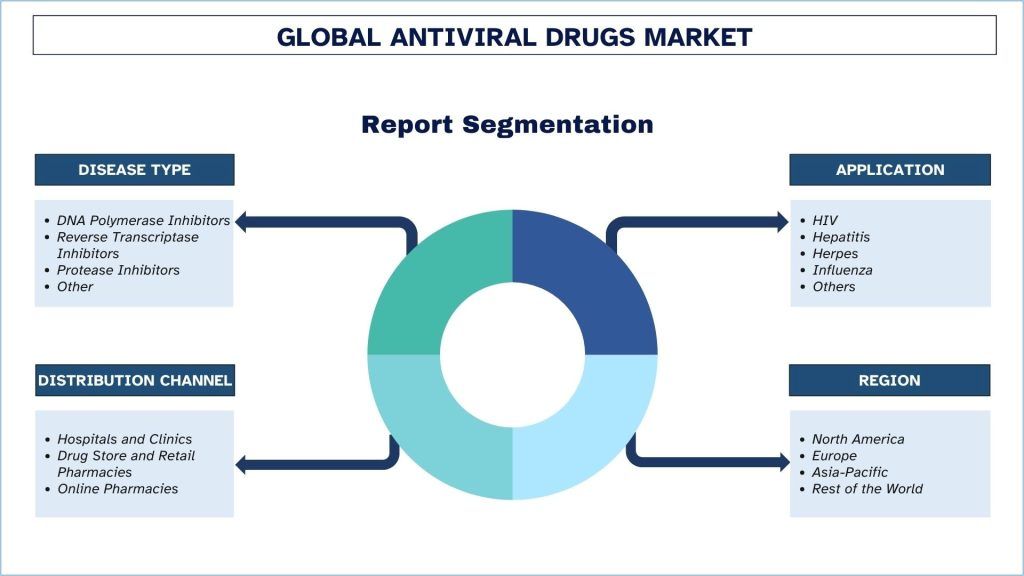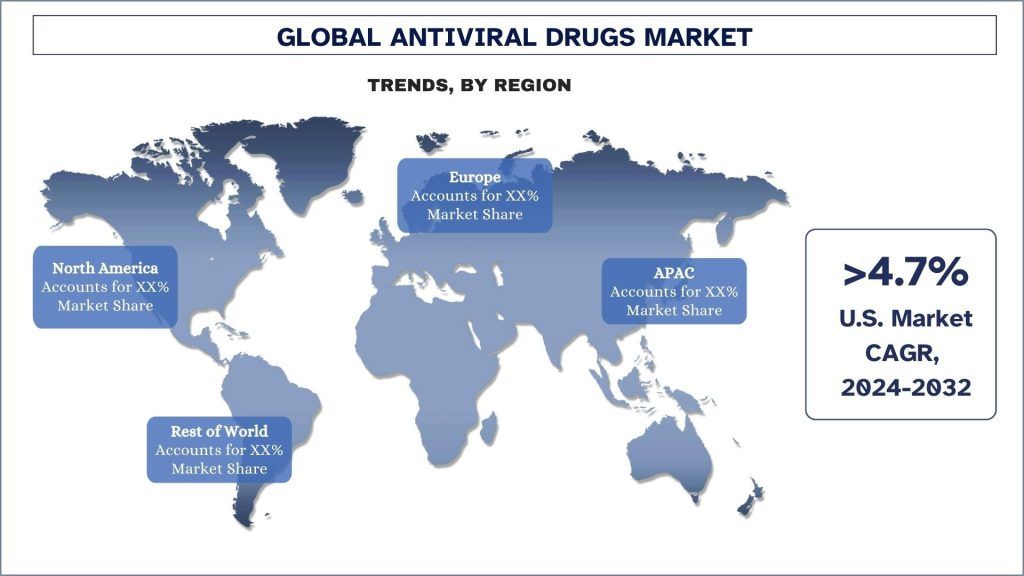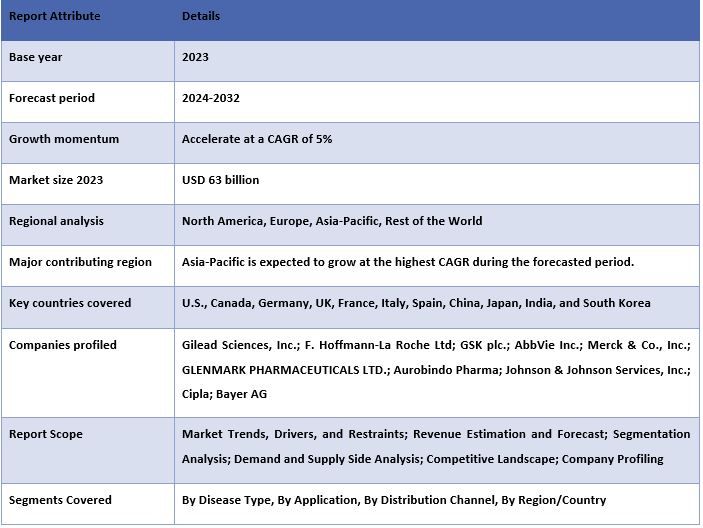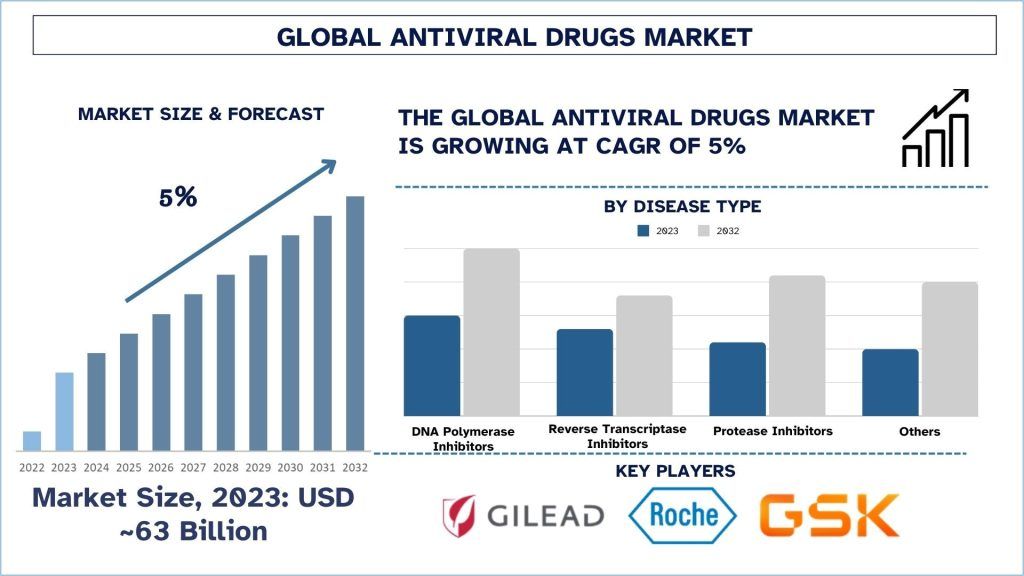- Trang chủ
- Về chúng tôi
- Ngành
- Dịch vụ
- Đọc
- Liên hệ với chúng tôi
Thị trường Thuốc kháng vi-rút: Phân tích Hiện tại và Dự báo (2024-2032)
Nhấn mạnh vào Nhóm Thuốc (Chất ức chế DNA Polymerase, Chất ức chế Reverse Transcriptase, Chất ức chế Protease và các loại khác); Ứng dụng (HIV, herpes, viêm gan, cúm và các loại khác); Kênh phân phối (bệnh viện và phòng khám, nhà thuốc & hiệu thuốc bán lẻ và nhà thuốc trực tuyến); Khu vực/Quốc gia (Bắc Mỹ (Hoa Kỳ, Canada, Phần còn lại của Bắc Mỹ); Châu Âu (Đức, Vương quốc Anh, Pháp, Ý, Tây Ban Nha, Phần còn lại của Châu Âu); Châu Á-Thái Bình Dương (Trung Quốc, Ấn Độ, Nhật Bản, Hàn Quốc, Phần còn lại của Châu Á-Thái Bình Dương); và Phần còn lại của Thế giới)
Quy mô & Dự báo Thị trường Thuốc kháng vi-rút
Thị trường Thuốc kháng vi-rút được định giá khoảng 63 tỷ USD vào năm 2023 và dự kiến sẽ tăng trưởng với CAGR đáng kể khoảng 5% trong giai đoạn dự báo (2024-2032) do sự gia tăng tỷ lệ mắc các bệnh nhiễm vi-rút như HIV, viêm gan, cúm và COVID-19 thúc đẩy nhu cầu về thuốc kháng vi-rút.
Phân tích Thị trường Thuốc kháng vi-rút
Thuốc kháng vi-rút được phân loại là một tác nhân điều trị được sử dụng trong việc phòng ngừa cũng như điều trị các bệnh nhiễm vi-rút để làm chậm sự phát triển và chu kỳ sinh sản của vi-rút trong sinh vật chủ. Thuốc kháng sinh khác với thuốc kháng vi-rút ở chỗ thuốc kháng sinh được sử dụng để tiêu diệt vi khuẩn, trong khi thuốc kháng vi-rút hoạt động bằng cách can thiệp vào chức năng của vi-rút để làm chậm sự tiến triển của bệnh, giảm tác động hoặc điều trị các triệu chứng. Các loại thuốc này có thể được sử dụng để điều trị các bệnh nhiễm vi-rút bao gồm HIV, viêm gan B và C, cúm và COVID-19 cũng như các bệnh nhiễm vi-rút khác.
Hơn nữa, nghiên cứu đang diễn ra và những tiến bộ công nghệ dẫn đến việc phát triển các loại thuốc kháng vi-rút hiệu quả và an toàn hơn, tăng cường các lựa chọn điều trị. Vào tháng 5 năm 2023, Cục Quản lý Thực phẩm và Dược phẩm Hoa Kỳ đã phê duyệt thuốc kháng vi-rút dạng uống Paxlovid (viên nén nirmatrelvir và viên nén ritonavir, đóng gói chung để sử dụng đường uống) để điều trị COVID-19 từ nhẹ đến trung bình ở người lớn có nguy cơ cao tiến triển thành COVID-19 nghiêm trọng, bao gồm nhập viện hoặc tử vong. Paxlovid là loại thuốc thứ tư — và là thuốc kháng vi-rút dạng uống đầu tiên — được FDA phê duyệt để điều trị COVID-19 ở người lớn. Do đó, đầu tư liên tục vào R&D là rất quan trọng để phát triển các loại thuốc kháng vi-rút mới và cải thiện các phương pháp điều trị hiện có. Các công ty đổi mới và thích ứng với các mối đe dọa vi-rút mới sẽ đạt được lợi thế cạnh tranh. Vào tháng 11 năm 2021, Pfizer tiếp tục đầu tư lên đến khoảng 1 tỷ USD để hỗ trợ sản xuất và phân phối phương pháp điều trị thử nghiệm này, bao gồm cả việc khám phá các lựa chọn sản xuất theo hợp đồng tiềm năng để giúp đảm bảo khả năng tiếp cận ở các quốc gia có thu nhập thấp và trung bình, đang chờ phê duyệt theo quy định.
Xu hướng Thị trường Thuốc kháng vi-rút
Phần này thảo luận về các xu hướng thị trường chính ảnh hưởng đến các phân khúc khác nhau của thị trường Thuốc kháng vi-rút theo xác định của các chuyên gia nghiên cứu của chúng tôi.
Phân khúc Chất ức chế sao chép ngược Chuyển đổi Ngành Thuốc kháng vi-rút
Điều này là do chất ức chế sao chép ngược, một phần của thuốc kháng vi-rút, có phần lớn cơ sở thị trường từ việc điều trị HIV/AIDS. Chúng bao gồm nucleoside và chất ức chế sao chép ngược không phải nucleoside, những chất này với vai trò là liệu pháp đầu tay giúp kích thích sự nhân lên của HIV bằng cách ức chế enzyme phiên mã ngược. Nó rất quan trọng đối với việc điều trị nhiễm HIV, cải thiện tình trạng của bệnh nhân và tăng tuổi thọ của họ, và do đó là một loại thuốc quan trọng. Tỷ lệ HIV/AIDS ngày càng tăng trên khắp thế giới và nhu cầu điều trị suốt đời. Vì công thức RTI là một lĩnh vực nghiên cứu rất tích cực, nên những đổi mới liên tục đang phát triển với một số công thức có tác dụng phụ ít hơn so với những công thức trước đó, hoặc thậm chí cải thiện hiệu quả thúc đẩy tăng trưởng thị trường. Ngoài ra, nhận thức và khả năng tiếp cận điều trị HIV ngày càng tăng trong các khu vực đang phát triển thúc đẩy thị trường RTI.

Bắc Mỹ dẫn đầu thị trường.
Bắc Mỹ chiếm thị phần lớn nhất của thị trường do tỷ lệ mắc các bệnh do vi-rút cao hơn, bao gồm HIV, viêm gan và cúm, do đó tạo ra nhu cầu về thuốc để chữa các bệnh này. Theo KFF.org năm 2024, hơn 1,2 triệu người đang sống chung với HIV ở Hoa Kỳ và ước tính có 31.800 ca nhiễm mới (các trường hợp ở những người đã được chẩn đoán và chưa được chẩn đoán) vào năm 2022. Có các hệ thống chăm sóc sức khỏe lành mạnh trong khu vực cũng như các tổ chức nghiên cứu nâng cao đảm bảo phát triển thuốc nhất quán. Ngoài ra, sự hỗ trợ cao của chính phủ và các quy tắc và quy định phát triển tốt cho thuốc giúp chúng dễ tiếp cận và an toàn hơn. Tỷ lệ chăm sóc sức khỏe cao và dân số bệnh nhân lớn là những yếu tố khác cũng góp phần vào sự tăng trưởng của thị trường. Hơn nữa, có một sự tập trung mạnh mẽ của những người chơi dược phẩm hàng đầu cùng với một môi trường thị trường cạnh tranh, đảm bảo sự tiến bộ liên tục với điều trị kháng vi-rút. Nhận thức và giáo dục của bệnh nhân cũng có thể là một yếu tố quan trọng để tỷ lệ chấp nhận thuốc cao hơn.

Tổng quan về Ngành Thuốc kháng vi-rút
Thị trường Thuốc kháng vi-rút có tính cạnh tranh, với một số người chơi toàn cầu và quốc tế. Các người chơi chính đang áp dụng các chiến lược tăng trưởng khác nhau để tăng cường sự hiện diện trên thị trường của họ, chẳng hạn như quan hệ đối tác, thỏa thuận, hợp tác, ra mắt sản phẩm mới, mở rộng địa lý và sáp nhập và mua lại. Một số người chơi lớn hoạt động trên thị trường là Gilead Sciences, Inc.; F. Hoffmann-La Roche Ltd; và GSK plc.; AbbVie Inc.; Merck & Co., Inc.; GLENMARK PHARMACEUTICALS LTD.; Aurobindo Pharma; Johnson & Johnson Services, Inc.; Cipla; Bayer AG.
Tin tức về Thị trường Thuốc kháng vi-rút
- Vào tháng 11 năm 2021, Pfizer Inc. đã công bố rằng họ đang tìm kiếm Giấy phép Sử dụng Khẩn cấp (EUA) cho ứng cử viên kháng vi-rút dạng uống đang được nghiên cứu, PAXLOVID (PF-07321332; ritonavir), để điều trị COVID-19 từ nhẹ đến trung bình ở những bệnh nhân có nguy cơ nhập viện hoặc tử vong cao.
- Vào tháng 1 năm 2022 – GlaxoSmithKline plc và Vir Biotechnology, Inc. đã công bố rằng Chính phủ Hoa Kỳ sẽ mua thêm 600.000 liều sotrovimab, một kháng thể đơn dòng đang được nghiên cứu để điều trị sớm COVID-19, cho phép tiếp cận rộng rãi hơn trên toàn quốc với sotrovimab cho bệnh nhân. 600.000 liều bổ sung sẽ được giao trong suốt quý đầu tiên của năm 2022. Thỏa thuận này là một sửa đổi đối với các cam kết trước đó đã được công bố với Chính phủ Hoa Kỳ vào tháng 11 năm 2021.
Phạm vi Báo cáo Thị trường Thuốc kháng vi-rút

Lý do nên mua báo cáo này:
- Nghiên cứu bao gồm phân tích kích thước và dự báo thị trường được xác thực bởi các chuyên gia hàng đầu trong ngành.
- Báo cáo trình bày đánh giá nhanh về hiệu suất tổng thể của ngành trong nháy mắt.
- Báo cáo bao gồm phân tích chuyên sâu về các đồng nghiệp nổi bật trong ngành, tập trung chủ yếu vào tài chính kinh doanh chính, danh mục sản phẩm, chiến lược mở rộng và các phát triển gần đây.
- Xem xét chi tiết các động lực, hạn chế, xu hướng chính và cơ hội hiện hành trong ngành.
- Nghiên cứu bao gồm toàn diện thị trường trên các phân khúc khác nhau.
- Phân tích sâu cấp khu vực của ngành.
Tùy chọn tùy chỉnh:
Thị trường Thuốc kháng vi-rút toàn cầu có thể được tùy chỉnh thêm theo yêu cầu hoặc bất kỳ phân khúc thị trường nào khác. Bên cạnh đó, UMI hiểu rằng bạn có thể có nhu cầu kinh doanh riêng, do đó, vui lòng kết nối với chúng tôi để nhận một báo cáo hoàn toàn phù hợp với yêu cầu của bạn.
Mục lục
Phương Pháp Nghiên Cứu Phân Tích Thị Trường Thuốc Kháng Virus (2022-2032)
Phân tích thị trường lịch sử, ước tính thị trường hiện tại và dự báo thị trường tương lai của thị trường Thuốc Kháng Virus toàn cầu là ba bước chính được thực hiện để tạo và phân tích việc áp dụng Thuốc Kháng Virus ở các khu vực chính trên toàn cầu. Nghiên cứu thứ cấp chuyên sâu đã được tiến hành để thu thập số liệu thị trường lịch sử và ước tính quy mô thị trường hiện tại. Thứ hai, để xác thực những thông tin chi tiết này, nhiều phát hiện và giả định đã được xem xét. Hơn nữa, các cuộc phỏng vấn sơ cấp chuyên sâu cũng đã được thực hiện với các chuyên gia trong ngành trên toàn bộ chuỗi giá trị của thị trường Thuốc Kháng Virus toàn cầu. Sau khi giả định và xác thực số liệu thị trường thông qua các cuộc phỏng vấn sơ cấp, chúng tôi đã sử dụng phương pháp tiếp cận từ trên xuống/từ dưới lên để dự báo quy mô thị trường hoàn chỉnh. Sau đó, các phương pháp phân tích chi tiết thị trường và phân tích tam giác dữ liệu đã được áp dụng để ước tính và phân tích quy mô thị trường của các phân khúc và phân khúc phụ của ngành. Phương pháp luận chi tiết được giải thích dưới đây:
Phân Tích Quy Mô Thị Trường Lịch Sử
Bước 1: Nghiên Cứu Chuyên Sâu về Các Nguồn Thứ Cấp:
Một nghiên cứu thứ cấp chi tiết đã được thực hiện để có được quy mô thị trường lịch sử của thị trường Thuốc Kháng Virus thông qua các nguồn nội bộ của công ty như báo cáo thường niên & báo cáo tài chính, các bài thuyết trình về hiệu suất, thông cáo báo chí, v.v. và các nguồn bên ngoài bao gồm tạp chí, tin tức & bài báo, ấn phẩm của chính phủ, ấn phẩm của đối thủ cạnh tranh, báo cáo ngành, cơ sở dữ liệu của bên thứ ba và các ấn phẩm đáng tin cậy khác.
Bước 2: Phân Khúc Thị Trường:
Sau khi có được quy mô thị trường lịch sử của thị trường Thuốc Kháng Virus, chúng tôi đã tiến hành phân tích thứ cấp chi tiết để thu thập thông tin chi tiết về thị trường lịch sử và chia sẻ cho các phân khúc & phân khúc phụ khác nhau cho các khu vực chính. Các phân khúc chính được bao gồm trong báo cáo như loại bệnh, ứng dụng, kênh phân phối và khu vực. Phân tích sâu hơn ở cấp quốc gia đã được tiến hành để đánh giá việc áp dụng tổng thể các mô hình thử nghiệm trong khu vực đó.
Bước 3: Phân Tích Yếu Tố:
Sau khi có được quy mô thị trường lịch sử của các phân khúc và phân khúc phụ khác nhau, chúng tôi đã tiến hành phân tích yếu tố chi tiết để ước tính quy mô thị trường hiện tại của thị trường Thuốc Kháng Virus. Hơn nữa, chúng tôi đã tiến hành phân tích yếu tố bằng cách sử dụng các biến phụ thuộc và độc lập như loại bệnh, ứng dụng, kênh phân phối và khu vực của thị trường Thuốc Kháng Virus. Một phân tích kỹ lưỡng đã được tiến hành cho các kịch bản cung và cầu, có xét đến các quan hệ đối tác hàng đầu, sáp nhập và mua lại, mở rộng kinh doanh và ra mắt sản phẩm trong lĩnh vực thị trường Thuốc Kháng Virus trên toàn cầu.
Ước Tính & Dự Báo Quy Mô Thị Trường Hiện Tại
Định cỡ thị trường hiện tại: Dựa trên những thông tin chi tiết hữu ích từ 3 bước trên, chúng tôi đã đạt được quy mô thị trường hiện tại, những người chơi chính trong thị trường Thuốc Kháng Virus toàn cầu và thị phần của các phân khúc. Tất cả các phần trăm chia sẻ cần thiết và phân tích chi tiết thị trường đã được xác định bằng cách sử dụng phương pháp thứ cấp đã đề cập ở trên và đã được xác minh thông qua các cuộc phỏng vấn sơ cấp.
Ước tính & Dự báo: Để ước tính và dự báo thị trường, trọng số đã được gán cho các yếu tố khác nhau bao gồm các yếu tố thúc đẩy & xu hướng, hạn chế và cơ hội dành cho các bên liên quan. Sau khi phân tích các yếu tố này, các kỹ thuật dự báo phù hợp, tức là phương pháp tiếp cận từ trên xuống/từ dưới lên đã được áp dụng để đạt được dự báo thị trường cho năm 2032 cho các phân khúc và phân khúc phụ khác nhau trên các thị trường lớn trên toàn cầu. Phương pháp nghiên cứu được áp dụng để ước tính quy mô thị trường bao gồm:
- Quy mô thị trường của ngành, về doanh thu (USD) và tỷ lệ chấp nhận của thị trường Thuốc Kháng Virus trên các thị trường lớn trong nước
- Tất cả các phần trăm chia sẻ, phân tách và phân tích chi tiết các phân khúc và phân khúc phụ của thị trường
- Những người chơi chính trong thị trường Thuốc Kháng Virus toàn cầu về các sản phẩm được cung cấp. Ngoài ra, các chiến lược tăng trưởng được áp dụng bởi những người chơi này để cạnh tranh trong thị trường đang phát triển nhanh chóng
Xác Thực Thị Phần và Quy Mô Thị Trường
Nghiên cứu sơ cấp: Các cuộc phỏng vấn chuyên sâu đã được thực hiện với những người có ảnh hưởng chính (KOL), bao gồm các Giám đốc điều hành cấp cao (CXO/Phó chủ tịch, Trưởng phòng kinh doanh, Trưởng phòng marketing, Trưởng phòng vận hành, Trưởng khu vực, Trưởng quốc gia, v.v.) trên khắp các khu vực chính. Các phát hiện nghiên cứu sơ cấp sau đó đã được tóm tắt và phân tích thống kê đã được thực hiện để chứng minh giả thuyết đã nêu. Thông tin đầu vào từ nghiên cứu sơ cấp đã được hợp nhất với các phát hiện thứ cấp, do đó biến thông tin thành những thông tin chi tiết hữu ích.
Phân Chia Người Tham Gia Sơ Cấp ở Các Khu Vực Khác Nhau

Kỹ Thuật Thị Trường
Kỹ thuật phân tích tam giác dữ liệu đã được sử dụng để hoàn thành việc ước tính thị trường tổng thể và đạt được các số liệu thống kê chính xác cho từng phân khúc và phân khúc phụ của thị trường Thuốc Kháng Virus toàn cầu. Dữ liệu đã được chia thành nhiều phân khúc và phân khúc phụ sau khi nghiên cứu các thông số và xu hướng khác nhau về loại bệnh, ứng dụng, kênh phân phối và khu vực của thị trường Thuốc Kháng Virus toàn cầu.
Mục tiêu chính của Nghiên cứu Thị trường Thuốc Kháng Virus Toàn cầu
Các xu hướng thị trường hiện tại & tương lai của thị trường Thuốc Kháng Virus toàn cầu đã được xác định chính xác trong nghiên cứu. Các nhà đầu tư có thể thu được những thông tin chi tiết chiến lược để làm cơ sở cho quyết định đầu tư của họ dựa trên phân tích định tính và định lượng được thực hiện trong nghiên cứu. Các xu hướng thị trường hiện tại và tương lai xác định sức hấp dẫn tổng thể của thị trường ở cấp khu vực, cung cấp một nền tảng cho người tham gia công nghiệp khai thác thị trường chưa được khai thác để hưởng lợi từ lợi thế của người đi đầu. Các mục tiêu định lượng khác của các nghiên cứu bao gồm:
- Phân tích quy mô thị trường hiện tại và dự báo của thị trường Thuốc Kháng Virus về giá trị (USD). Ngoài ra, hãy phân tích quy mô thị trường hiện tại và dự báo của các phân khúc và phân khúc phụ khác nhau.
- Các phân khúc trong nghiên cứu bao gồm các lĩnh vực loại bệnh, ứng dụng, kênh phân phối và khu vực.
- Xác định và phân tích khuôn khổ pháp lý cho Thuốc Kháng Virus
- Phân tích chuỗi giá trị liên quan đến sự hiện diện của các trung gian khác nhau, cùng với việc phân tích hành vi của khách hàng và đối thủ cạnh tranh của ngành.
- Phân tích quy mô thị trường hiện tại và dự báo của thị trường Thuốc Kháng Virus cho khu vực chính.
- Các quốc gia lớn của khu vực được nghiên cứu trong báo cáo bao gồm Châu Á Thái Bình Dương, Châu Âu, Bắc Mỹ và Phần còn lại của Thế giới
- Hồ sơ công ty của thị trường Thuốc Kháng Virus và các chiến lược tăng trưởng được các công ty tham gia thị trường áp dụng để duy trì thị trường đang phát triển nhanh chóng.
- Phân tích chuyên sâu ở cấp khu vực về ngành
Câu hỏi thường gặp Câu hỏi thường gặp
Câu hỏi 1: Quy mô và tiềm năng tăng trưởng hiện tại của thị trường Thuốc kháng vi-rút là gì?
Q2: Những yếu tố nào thúc đẩy sự tăng trưởng của thị trường Thuốc kháng vi-rút?
Q3: Phân khúc nào chiếm thị phần lớn nhất trong thị trường Thuốc kháng vi-rút theo sản phẩm?
Q4: Đâu là những xu hướng chính trên thị trường Thuốc kháng virus?
Q5: Khu vực nào sẽ chiếm lĩnh thị trường Thuốc kháng virus?
Liên quan Báo cáo
Khách hàng đã mua mặt hàng này cũng đã mua











